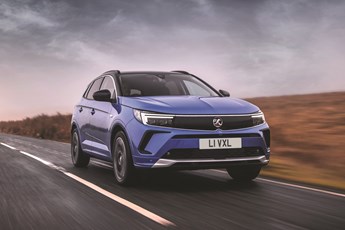We use cookies to ensure that we give you the best experience on our website. If you continue without changing your settings, we will assume that you are happy to receive all cookies on the Business Car website. However, if you would like to, you can change your cookies at any time

The start point for the best source of fleet information |
Model update: Vauxhall Grandland
Date: 23 May 2022 | Author: Sean Keywood

|
|
||||||||
For company car fleets, the main variants of interest with the newly-facelifted Vauxhall Grandland SUV range are clearly the plug-in hybrids, as reviewed by Business Car last month. However, petrol and diesel versions of the model are also still available, and now we've taken the opportunity to sample the former.
You might expect the petrol Grandland to feel rather pedestrian compared with the PHEV, as its 1.2-litre engine produces 130hp against the hybrid's 225hp. However, the petrol version has a trump card in the form of lightness. It's more than 350kg lighter than the PHEV, and as well as allowing for decent acceleration (accompanied by a fun three-cylinder engine note), this weight saving also helps the petrol in other areas. While the PHEV doesn't handle badly, the petrol Grandland feels more nippy and agile in bends, and its ride quality is also better resolved also, meaning a more pleasant driving experience all round, allowing better use of the enjoyably light but accurate steering. Our test car was specced with eight-speed automatic transmission, which works well - a six-speed manual is also available, costing £1,650 less on P11D and sitting one BIK tax band lower thanks to slightly better official CO2 emissions.
Petrol (and diesel) Grandlands also benefit from a bigger boot than the PHEV, at 514 litres versus 390, with the former a competitive figure in this segment. Top-spec models also come with a load-through rear seat hatch for extra practicality.
Of course, the petrol Grandland gets nowhere near competing with the PHEV on economy and emissions - 45.6mpg and 146g/km plays 192mpg and 31g/km with equivalent specs under official WLTP testing. However, the petrol is more than £4,000 cheaper to buy. Plus, it should also be noted, the Grandland also looks well priced against rival manufacturers' models - although the expected residual value of our test spec is a little low.
In contrast to the PHEV Grandland we tried last month, which came with the mid-range GS Line equipment grade, our petrol test car was in range-topping Ultimate spec. At least, it was in theory. In reality, Vauxhall's press fleet hadn't yet caught up with the range rationalisation the manufacturer carried out with several of its model ranges, including the Grandland, earlier this year. This reduced the number of equipment grades available with the Grandland to three, and discontinued the nominal Elite spec of our test car. This meant that some equipment standard with the Ultimate grade, such as Alcantara seat trim and alloy pedals, was not fitted. We'll therefore give the model the benefit of the doubt on interior quality, as in the spec tested there wasn't much sense of improvement over the mid-range GS Line version we tested previously, and the rather gloomy ambience of that model's interior was largely retained. As with that car though, the new 12in instrument cluster and 10in touchscreen do at least up the model's technology game.
Vauxhall Grandland Ultimate 1.2 Turbo 130PS 8-Speed Auto
P11D: £33,845
Residual value: 37.54%
Depreciation: £21,138
Fuel: £9,780
Service, maintenance and repair: £2,100
Cost per mile: 55.03p
Fuel consumption: 45.6mpg
CO2 (BIK %): 146g/km (34%)
BIK 20/40% a month: £192/£383
Luggage capacity: 514 litres
Engine size/power: 1,199cc/130hp
Verdict |
7/10 |
|||
 |
|
 |
|
|











